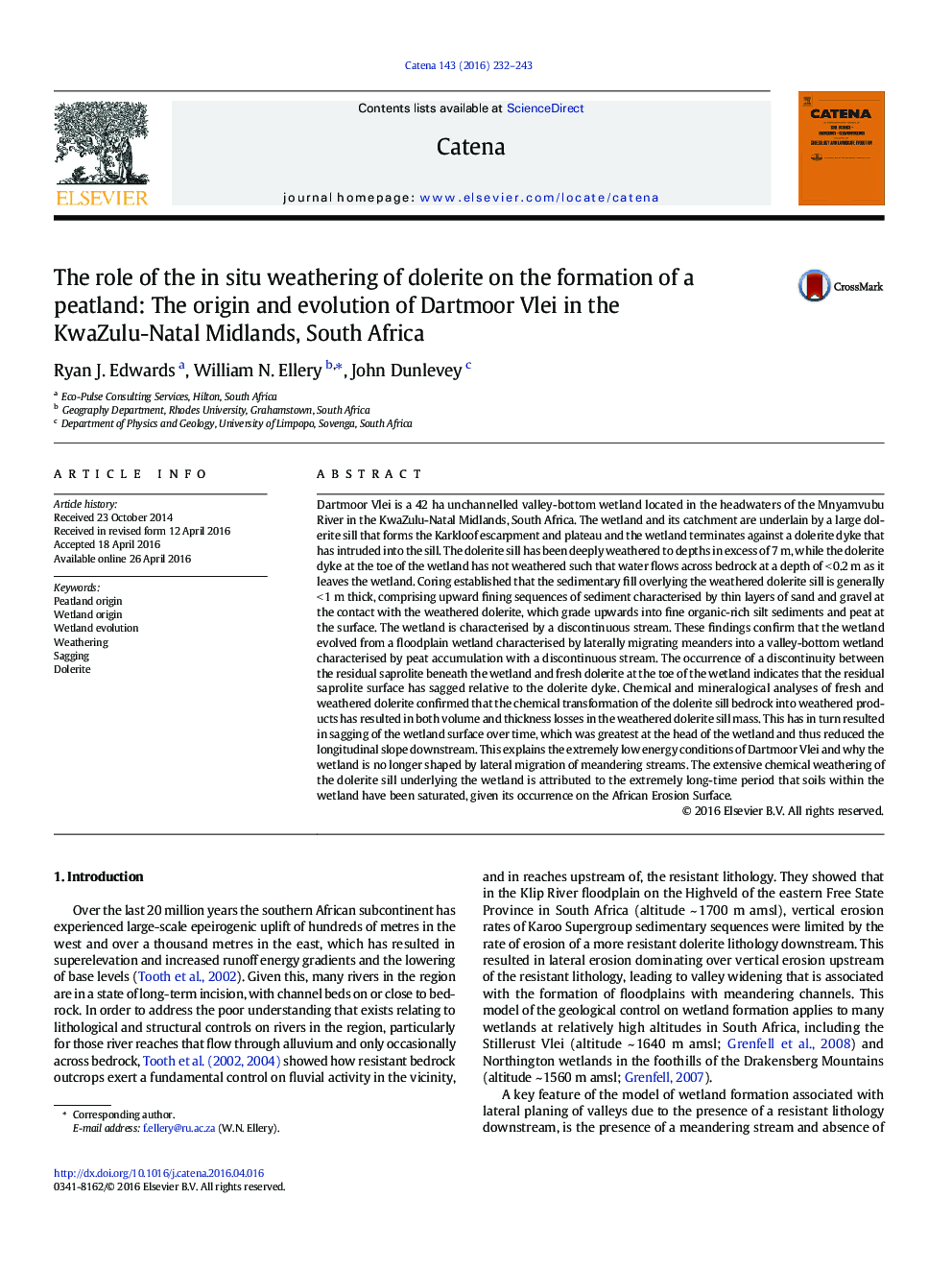| کد مقاله | کد نشریه | سال انتشار | مقاله انگلیسی | نسخه تمام متن |
|---|---|---|---|---|
| 6407887 | 1629209 | 2016 | 12 صفحه PDF | دانلود رایگان |
عنوان انگلیسی مقاله ISI
The role of the in situ weathering of dolerite on the formation of a peatland: The origin and evolution of Dartmoor Vlei in the KwaZulu-Natal Midlands, South Africa
دانلود مقاله + سفارش ترجمه
دانلود مقاله ISI انگلیسی
رایگان برای ایرانیان
موضوعات مرتبط
مهندسی و علوم پایه
علوم زمین و سیارات
فرآیندهای سطح زمین
پیش نمایش صفحه اول مقاله

چکیده انگلیسی
Dartmoor Vlei is a 42Â ha unchannelled valley-bottom wetland located in the headwaters of the Mnyamvubu River in the KwaZulu-Natal Midlands, South Africa. The wetland and its catchment are underlain by a large dolerite sill that forms the Karkloof escarpment and plateau and the wetland terminates against a dolerite dyke that has intruded into the sill. The dolerite sill has been deeply weathered to depths in excess of 7Â m, while the dolerite dyke at the toe of the wetland has not weathered such that water flows across bedrock at a depth of <Â 0.2Â m as it leaves the wetland. Coring established that the sedimentary fill overlying the weathered dolerite sill is generally <Â 1Â m thick, comprising upward fining sequences of sediment characterised by thin layers of sand and gravel at the contact with the weathered dolerite, which grade upwards into fine organic-rich silt sediments and peat at the surface. The wetland is characterised by a discontinuous stream. These findings confirm that the wetland evolved from a floodplain wetland characterised by laterally migrating meanders into a valley-bottom wetland characterised by peat accumulation with a discontinuous stream. The occurrence of a discontinuity between the residual saprolite beneath the wetland and fresh dolerite at the toe of the wetland indicates that the residual saprolite surface has sagged relative to the dolerite dyke. Chemical and mineralogical analyses of fresh and weathered dolerite confirmed that the chemical transformation of the dolerite sill bedrock into weathered products has resulted in both volume and thickness losses in the weathered dolerite sill mass. This has in turn resulted in sagging of the wetland surface over time, which was greatest at the head of the wetland and thus reduced the longitudinal slope downstream. This explains the extremely low energy conditions of Dartmoor Vlei and why the wetland is no longer shaped by lateral migration of meandering streams. The extensive chemical weathering of the dolerite sill underlying the wetland is attributed to the extremely long-time period that soils within the wetland have been saturated, given its occurrence on the African Erosion Surface.
ناشر
Database: Elsevier - ScienceDirect (ساینس دایرکت)
Journal: CATENA - Volume 143, August 2016, Pages 232-243
Journal: CATENA - Volume 143, August 2016, Pages 232-243
نویسندگان
Ryan J. Edwards, William N. Ellery, John Dunlevey,